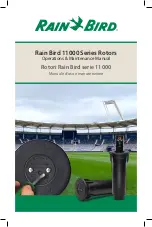
Thermocouple Restrictions
B–2
Publication 1794-6.5.7
E (Nickel–Chromium vs Copper–Nickel <Constantan*>) Type
Thermocouple
“Type E thermocouples are recommended by the ASTM Manual
[1970] for use in the temperature range from –250 to 871C in
oxidizing or inert atmospheres. The negative thermoelement is
subject to deterioration above about 871C, but the thermocouple may
be used up to 1000C for short periods.”
“The ASTM Manual [1970] indicates the following restrictions .. at
high temperatures. They should not be used in sulfurous, reducing or
alternately reducing and oxidizing atmospheres unless suitably
protected with protecting tubes. They should not be used in vacuum
(at high temperatures) for extended times, because the Chromium in
the positive thermoelement vaporizes out of solution and alters the
calibration. They should also not be used in atmospheres that
promote ”green–rot” corrosion (those with low, but not negligible,
oxygen content).”
“The negative thermoelement, a copper–nickel alloy, is subject to
composition changes under thermal neutron irradiation since the
copper is converted to nickel and zinc.”
“ASTM Standard E230–72 in the Annual Book of ASTM Standards
[1972] specifies that the standard limits of error for the Type E
commercial thermocouples be +/–1.7C between 0 and 316C and
+/–1/2 percent between 316 and 871C. Limits of error are not
specified for Type E thermocouples below 0C. Type E
thermocouples can also be supplied to meet special limits of error,
which are less than the standard limits of error given above:
+/–1.25C between 0 and 316C and +/–3/8 percent between 316 and
871C. The recommended upper temperature limit for protected
thermocouples, 871C, applies to AWG 8 (3.3mm) wire. For smaller
wires the recommended upper temperature decreases to 649C for
AWG 14 (1.6mm), 538C for AWG 20 (.8mm) and 427C for AWG 24
or 28 (0.5 or 0.3mm).
J (Iron vs Copper–Nickel <Constantan*>) Type Thermocouple
The J thermocouple “is the least suitable for accurate thermometry
because there are significant nonlinear deviations in the
thermoelectric output from different manufacturers. ... The total and
specific types of impurities that occur in commercial iron change
with time, location of primary ores, and methods of smelting.”
Summary of Contents for 1794-IT8
Page 1: ...User Manual Thermocouple Millivolt Input Module Cat No 1794 IT8 Allen Bradley ...
Page 4: ...soc ii Summary of Changes Publication 1794 6 5 7 April 1997 ...
Page 8: ...Table of Contents iv Publication 1794 6 5 7 ...
Page 14: ...Overview of FLEX I O and your Thermocouple mV Module 1 4 Publication 1794 6 5 7 ...
Page 64: ...Specifications A 10 Publication 1794 6 5 7 March 1997 ...











































